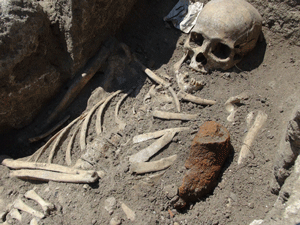
(AP Photo)
Among more than 600 rather
typical graves found
in a church graveyard in
the Bulgarian Black Sea town of
Sozopol were a pair of skeletons
bearing witness that at least two
of the town's inhabitants were
thought to require special treatment
after death. One of the skeletons
had a plowshare-like object
driven through the left side of his
rib cage, while the other had an
unidentifiable metal object in his
solar plexus. According to archaeologist
Dimitar Nedev, head of the Sozopol Archaeological
Museum, who found the skeletons, these burials are evidence
of protection against vampirism—the belief that the dead
would leave their graves.
The site includes two overlapping churches in use from
the sixth to seventeenth centuries, and although Nedev was
able to date the two graves to the fourteenth century, he says
there is little information about who
they might have belonged to. During
the Middle Ages, Bulgaria was
famous for practicing Manichean
Bogomilism. The sect called for
a return to the teachings of early
Christianity and a rejection of the
political ambitions of the reigning
ecclesiastical authorities, Nedev
says. "The Christian rituals practiced
then—and now—still included
many pagan elements," he explains.
Such rituals are "particularly well
preserved" in the Sozopol site, as
well as in the surrounding Strandzha region.
Bulgaria has some 100 other known "vampire" burials,
but Nedev is quick to take a friendly jab at the "explosive"
interest at the Sozopol site vampires. "It is not as if the word
‘vampire' was written on their foreheads or they had very
long teeth," he says with a smile.

